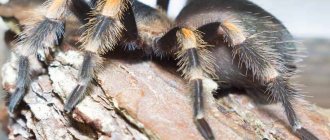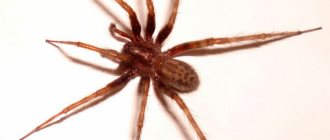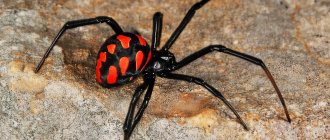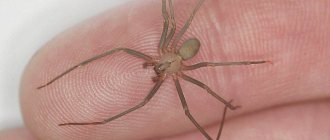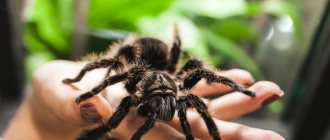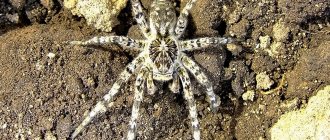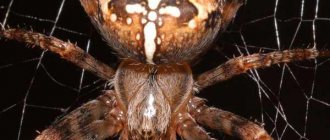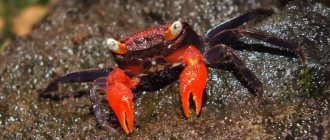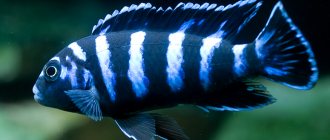Brachypelma albopilosum is a tarantula spider that is ideal for keeping at home. He has gained enormous popularity among exotic lovers due to his unpretentiousness, calm disposition and unusually beautiful appearance - he has a large body covered with hairs, which gives him a rather attractive appearance. In addition, the bite of Brachypelma albopilosum poses absolutely no danger to humans, since there are no toxins in its saliva. The female spider lives quite a long time - up to 20 years.
The bite of Brachypelma albopilosum poses absolutely no danger to humans.
Characteristics of Brachypelma albopilosum:
Adult size: The spider reaches up to 7 centimeters in body length and up to 16 centimeters in leg span, which gives it an impressive appearance.
Growth rate: Spiders of the genus Brachypelma and in particular Brachypelma albopilosum grow quite slowly, females reach sexual maturity by 2.5 years, males by about 1.5 years of life.
Lifespan: Females of Brachypelma albopilosum live up to 20 years.
Variety: All spiders of this genus belong to the terrestrial type of tarantulas; they prefer to hide in tree roots or other natural shelters, and can dig small holes.
Irritating hairs: Yes, the spider is not shy about using them, which can cause irritation where they come into contact with the skin.
Venom: The venom of this species is not dangerous and is comparable to that of a wasp.
Aggressiveness and danger: The spider is very calm, not fast, not nervous, not aggressive and not at all dangerous, Brachypelma albopilosum can be recommended as the first spider.
Description of the spider
The Brachypelma albopilosum spider is a representative of the rich fauna of the forests of Costa Rica and Honduras. Since its cost is not so high, anyone can buy such an unusual pet.
Brachypelma albopilosum l3 received the name tarantula thanks to one painting painted back in the 18th century from the words of the famous researcher Maria Sibylle Merian. The woman described in detail in her works the process of a brachypelma attacking a hummingbird right in its nest, and the artist created a canvas depicting this action. The saliva of a tarantula is not dangerous to humans, but under natural conditions the spider uses irritating hairs located along the entire body for defense purposes. Therefore, as soon as he starts combing them, you urgently need to move away from him. Otherwise, hairs caught on the face may cause irritation of the mucous membranes.
External characteristics
Unlike other tarantulas, brachypelma has a rather modest color, but this does not prevent the spider from looking chic.
Brachypelma albopilosum has the following external characteristics:
- the body is painted golden-bronze;
- the maximum length of the body reaches 7 cm;
- the thick hairs that cover the entire body of the spider have a dark brown or black tint with pink tints;
- can make large swings of its paws (up to 16 cm).
By nature, this is a rather calm, sedentary animal, capable of sitting all day in one position without even moving. However, at a young age, Brachypelma albopilosum is highly active and mobile, so it is necessary to constantly ensure that the terrarium lid is closed, otherwise the spider will escape. You need to pick it up with great care so as not to scare the tarantula. Otherwise, he may shed his hairs.
At a young age, Brachypelma albopilosum is highly active and mobile.
Albopilosum prefers to live under logs or stones, as well as in earthen voids. He can even make his own home by digging a hole. Has excellent eyesight as it is a nocturnal hunter.
Molting of Brachypelma albopilosum
During the molting period, which occurs throughout the life of the tarantula, its active growth and development is observed. When this period begins, you can notice a change in the spider's behavior . This is expressed as follows:
- there is a decrease in appetite up to complete refusal of food;
- he becomes inactive and may even freeze completely;
- the fleecy cover darkens.
Before the onset of molting, the tarantula begins to prepare - it weaves a rug from a web. The preparation process itself, as well as the duration of the period after molting, range from one to 24 weeks. The actual molting takes about 20 minutes, after which the tarantula lies down on its mat with its paws up or on its side.
Disturbances in the process (rupture of the new skin or incomplete peeling of the old one) can cause the death of the tarantula. The causes of the complications have not been precisely established, but it is assumed that this is due to excessively high or, conversely, very low air humidity. In addition, disturbances can be caused by severe stress or the spider's restless state.
Keeping Brachypelma albopilosum at home:
As noted above, keeping Brachypelma albopilosum is not difficult, the conditions are the most standard. A spacious plastic container with a horizontal orientation can be chosen as a terrarium; a terrarium of 30x30x30 centimeters is suitable for an adult. coconut substrate may be ideal if you add more, the spider can dig small holes. Humidity for Brachypelma albopilosum is maintained at 70-80%, which is easily achieved by installing a drinker and watering half or 1/3 of the substrate; do not use a spray bottle; sudden changes in humidity are not desirable. Maintain the temperature in the range of 24-28 degrees Celsius. You can also install shelters in a terrarium with Brachypelma albopilosum, but this is not necessary.
What does Brachypelma albopilosum cause?
Generally, tarantulas do not face many health problems if they are kept in an appropriate environment and fed a proper diet. But if your spider has become lethargic or isn't eating, consult your veterinarian to find out the root cause.
Most often, this behavior is a sign that your spider is ready to shed. During molting, the spider sheds its exoskeleton and forms a new one. And many spiders moult while lying on their backs with their legs curled, which some owners unfamiliar with the process may mistake for a dying spider.
The actual shedding is completed in a few hours, but the entire process can take weeks. The new exoskeleton must harden to protect the spider. However, if you think your spider's shedding is taking longer than it should or seems abnormal, discuss it with your veterinarian.
Rules of care and maintenance
Spiders are perhaps the easiest animals to keep at home, although it cannot be said that they do not need care at all. The most important thing is that they behave very calmly and do not leave as much garbage behind them as from other animals. To keep a tarantula spider, you will have to acquire either an aquarium or a terrarium. The most important thing is that conditions close to natural ones be created inside such a container. For spiders living under the surface of the earth, it is necessary that at the bottom there is a substrate at least 5 cm thick, consisting of soil and bark. For individuals living above the surface of the earth, it is necessary that driftwood be present. Here the spider will weave a web and hide in its shelter.
It is important to know! Spiders prefer twilight, so they do not need bright lighting. In addition, the terrarium should be placed in a warm corner of the apartment or room, away from direct sunlight. In winter, additional heating will be required to maintain the temperature inside the container at +25 degrees.
Care involves monitoring the cleanliness of the terrarium, regularly removing food debris, skin after molting, removing young spiders, as well as males after mating, otherwise cannibalism is possible. It is imperative to maintain humidity at the required level to prevent the skin from drying out. If this is not done, the animal will begin to get seriously ill.
Reproduction
The breeding season of almost all brachypelma species occurs during the monsoon season.
The male and female spiders are similar in color and pattern, but have some differences in morphology, color intensity, body size and lifespan.
The spider's clutch matures in the dry winter months and usually breaks open in late spring, from where small spider nymphs emerge.
Some breeding studies of Brachypelma species have shown that adult females do not mate or lay eggs every year, although they have not yet been able to prove this.
Brachypelma Smitty spider in a glass spider cage
Temperament
Brachypelma smithie is a non-hostile and calm species of spider . However, the tarantula is able to use the protective hairs located on the abdomen as defense. Incidents with bites, or attempts at them, are quite rare. Spider venom does not pose a particular threat to human life. Despite this, the risk of consequences that contribute to the development of allergies, leading to death, cannot be ignored. Brachypelma does not react hostilely to cleaning the terrarium, but waits patiently and calmly for it. This helps reduce the risk of a bite at this moment.
What to feed a tarantula spider at home
Many believe that, judging by the name, these spiders feed on birds. In fact, this is not the case, since the diet of such animals in nature is very diverse. Therefore, the diet of tarantula spiders consists of:
- From crickets.
- From grasshoppers.
- From cockroaches.
- From flies.
- From moths.
- From moth caterpillars.
Tarantula spiders kept at home are occasionally given chicken (raw), fish, and small rodents. Adults are fed 2 times a week, and juveniles are given food 4 times a week.
Where to buy spider Brachypelma albopilosum
Domestic curly tarantula spiders You can sometimes find this species in pet stores. But it is often easier to contact a reputable breeder or exotic pet rescue group.
Expect to pay on average between 1,500 and 5,000 rubles.
The seller must provide you with information about the origin and health of the animal. It is best to observe the spider before making an attack. Make sure he is active, with shiny hairs and a round belly. A dull or wrinkled appearance often indicates illness. If possible, ask to see how the spider eats.
House spider tarantula for beginners
As a rule, large spiders are found in the tropics, where the climate is constantly warm and humid. Some species prefer to live in the ground, where they build entire labyrinths, as well as in trees, constructing huge trapping nets. Often, the habitat of some species depends on age: at a young age they are found in the thickness of the earth, and as they grow older they move to trees or plants.
It is important to know! When keeping the tarantula spider at home, conditions should be created that are close to natural. To do this, before purchasing it, you need to study the features of the environment in which they prefer to live. If this is not done, the animal will quickly die from stress.
You should always remember that these spiders are poisonous, despite the fact that they have a peaceful nature and do not show aggression. For beginners, we can recommend the following types:
- Brachypelma Albopilosum (Brachipelma Albopilosum) leads a terrestrial way of life and is distinguished by the most calm behavior. The body size, which has a pinkish-brownish color, reaches about 16 cm. The spider bites painfully, but its bite does not pose a danger to humans. Females can live about 20 years, while males live only 3 years. It is unpretentious in care, and the diet is based on small insects. Can weave a web, although not a large one.
- Avicularia Versicolor prefers to live in trees. Adults are distinguished by their bright colors, with a predominance of blue-blue tones. The body length is about 5 cm, and together with the paws - 16 cm. It weaves a huge web, making a hole out of it for itself and securing it under the ceiling of the terrarium. It leads a nocturnal lifestyle, and during the daytime it stays in its shelter. It moves quite quickly, so it is very difficult to catch it. Females can live for about 8 years, while males can live for only a couple of years. Although the spider is poisonous, its poison is not dangerous to humans. You can pick up the spider without any problems, since its hairs do not contain toxic components.
For professionals, the species “Lasiodora Parahybana”, “Grammostola”, “Acanthoscurria” are suitable. The Goliath tarantula is considered a real decoration of any collection, and is also one of the most beautiful spiders in the world. Reaches a length of about 28 centimeters.
Distribution of Brachypelma Böhme.
Brachypelma Boehme is distributed in tropical and subtropical forests along the Pacific coast of Mexico in the state of Guerrero. The western border of the range runs along the Balsas River, flowing between the states of Michoacan and Guerrero; in the north, the habitat is limited by the high peaks of the Sierra Madre del Sur.
Brachypelma boehmei can be kept at home as a pet
Danger to humans
Before you get such an undemanding pet at home, you should find out how poisonous it is. It must be remembered that although this type of spider can bite a person, these bites do not pose a danger.
The animal can bite if it feels its life is threatened, but before that it can rise on its hind legs and create menacing hissing sounds. The tarantula spider bites with chelicerae, at the end of which there are fangs, the length of which is about 2 cm. During the bite, it injects poison.
The bite site becomes inflamed, followed by swelling and swelling. All this is accompanied by pain. After about a week, the negative consequences of the bite disappear. This is especially true for people prone to allergies, as well as those with weakened immune systems. After a bite, such people experience a deterioration in their general health and severe weakness, with nausea, diarrhea, dizziness and headache.
Spiders cannot be trained in any way, so a person must study their behavior patterns. If the spider has poisonous hair, then it is better to handle it while wearing gloves, otherwise it may irritate the skin.
It is important to know! There is a category of people suffering from arachnophobia - fear of spiders. If such a person accidentally and unexpectedly encounters a tarantula spider, he may die of fear. In this regard, it is necessary to ensure that the animal is not able to leave the terrarium and does not start traveling around a person’s home, or even worse, among its neighbors.
Appearance
The Mexican red-knee tarantula is famous for its popularity due to its bright colors and large size . From the name of the spider itself, one can identify the most distinctive and memorable feature of its appearance – the red knee. The tarantula has a dark brown body color close to black. On its paws, in the joint area, there are shades of red or orange with a yellow or white frame.
After each molt, the color of the spider becomes more expressive and contrasting. Its body is covered with thick hairs of light pink or brown color. When stressed, the tarantula sheds hairs from its abdomen. If a hair gets on a person's skin, irritation and redness may occur, and hair getting into the eyeball can cause vision impairment. Brachypelma smithy has the following physique: plump abdomen, extensive cephalothorax, massive paws.
The multi-colored coloring, reminiscent of a decorated Christmas tree, awakens in a person not disgust and fear of the spider, but the desire to acquire it. The white ends of the hairs give the tarantula a special appearance of softness . The body length of the tarantula reaches 7-8 cm, and the size of the paws is 17 cm. There is a sexual difference between male and female: females are somewhat larger.
Brachypelma activity is observed at night. During the daytime, the tarantula spider prefers to hide under stones or in dug holes to escape the heat, because they live in places with a dry climate. During molting, Brachypelma smithy puts on an extraordinary and unforgettable spectacle: the spider pleases the eye with a mixture of shades of red and black or yellow and black. With each subsequent molt, the color of the tarantula becomes more expressive: dark shades become almost black, and areas with a red tint increase the degree of red color. On average, the gap between molts is about two months.
